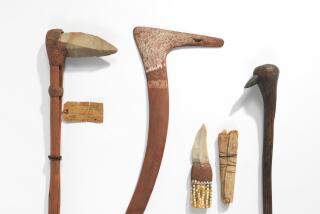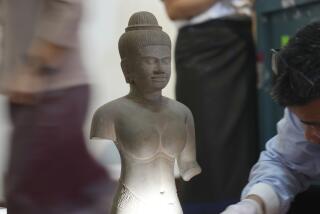Twist of Fate for Collections Heading to the Bay
Five months before opening its new facility in San Francisco’s civic center, the Asian Art Museum has acquired nearly 1,000 works of art as donations from two major private collections. The acquisitions, announced Wednesday, consist of 832 Japanese bamboo baskets and related works from the collection of L.A.-based Lloyd Cotsen and 167 pieces of Southeast Asian art from the Doris Duke Charitable Foundation, in New York.
The combined acquisition is the most significant gift of art to the museum since industrialist Avery Brundage’s founding donation of nearly 8,000 objects in the early 1960s, museum officials said. Having outgrown its home in Golden Gate Park, the museum will open on Jan. 23 in the city’s former Main Library with a holding of more than 15,000 objects spanning 6,000 years. Selections from the Cotsen and Duke gifts, displayed on a rotating basis, will be a permanent feature in the new galleries.
Cotsen, the former chief executive and chairman of Neutrogena, is a longtime collector of Japanese art, international folk art and children’s books who lives in Los Angeles. He said he considered giving his bamboo basket collection to several museums but settled on the Asian Art Museum because “they wanted it, actively pursued it and would take all the baskets.”
His relationship with the San Francisco institution began in 2000, when it presented “Bamboo Masterworks: Japanese Baskets From the Lloyd Cotsen Collection,” a traveling exhibition of 100 baskets, included in his gift. The show appeared in Southern California last fall at the Pacific Asia Museum in Pasadena, and it will wind up its tour in Japan.
Assembled over the past 40 years, Cotsen’s holding covers the Edo period (1615-1868) to the present and encompasses a wide variety of techniques and aesthetic effects. Most of the baskets were made to be used in tea ceremonies, for flower arrangements or as charcoal carriers, but Cotsen views them as art.
“I look at them with a Western eye, as portable sculpture,” he said. “They appeal to me architecturally and spatially.” One notable example, “The Shimmering of Heated Air”--which represents candlelight refracted through faceted crystal--was made in 1958 by Shono Shounsai, the first artist working in bamboo to be designated a Japanese Living National Treasure.
Cotsen also gave the museum an endowment of an undisclosed sum to ensure that his gift would be “a living collection,” he said. The funds will be used for publications, research and public programs on Japanese bamboo basketry.
The works donated by the Doris Duke Charitable Foundation were amassed by Doris Duke, the only child of James Buchanan Duke, a founder of the American Tobacco Co. and Duke Energy Co. and a benefactor of Duke University in North Carolina. Doris Duke, who died in 1993, collected more than 400 rare sculptures, paintings, manuscripts and ceramics from Thailand, Burma (now Myanmar), Cambodia and Laos, along with 1,800 less valuable decorative and functional items. The collection has been housed at Duke Gardens in Hillsborough, N.J., but trustees of the foundation decided to distribute it to museums and other public art institutions. Donations to several museums are under discussion, but the Asian Art Museum is the first to receive a gift.
The donation includes 70 Thai paintings and manuscripts; Thai, Burmese and Cambodian sculptures in bronze, stone and wood; and Thai and Burmese furniture for temples and aristocratic homes. Among the most spectacular pieces are a Cambodian bronze Buddha, made between 1100 and 1250, and an 11-foot-tall Burmese gilded throne from the late 19th century.
These works and many others will go on display when the museum completes its move into the former Main Library, a 1917 Beaux Arts-style building that has been renovated and adapted to meet the needs of its new occupant. The $160.5-million project was designed by Italian architect Gae Aulenti, best known for transforming a derelict Paris train station into the Musee d’Orsay.
More to Read
The biggest entertainment stories
Get our big stories about Hollywood, film, television, music, arts, culture and more right in your inbox as soon as they publish.
You may occasionally receive promotional content from the Los Angeles Times.










